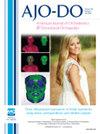Evaluation of the reliability of palatal rugae as a reference area in digital superimposition after slow maxillary expansion treatment
IF 2.7
2区 医学
Q1 DENTISTRY, ORAL SURGERY & MEDICINE
American Journal of Orthodontics and Dentofacial Orthopedics
Pub Date : 2025-01-08
DOI:10.1016/j.ajodo.2024.11.006
引用次数: 0
Abstract
Introduction
This study aimed to evaluate the stability of palatal rugae patterns after slow maxillary expansion (SME) treatment and the reliability of the rugae region as a reference region in digital superimposition.
Methods
The SME group comprised 21 subjects with Angle Class I or Class II dental malocclusion with unilateral or bilateral crossbite and constricted maxilla and were selected before the pubertal peak. Intraoral scans were captured via the intraoral scanner iTero Element software (version 1.13; Align Technology, San Jose, Calif) before treatment and after completion of 12 rotations of the screw in the expansion appliance. Patients rotated the screw once a week by the established protocol. The digital data of the impressions were analyzed using GOM Inspect 3D analysis software (version 2018; GOM GmbH, Braunschweig, Germany). Dimensional changes in rugae after SME were measured with MeshLab software (version 2022.02, the Visual Computing Lab of CNR-ISTI, Italy). For the statistical analysis, the Shapiro-Wilk test was used to assess normality, whereas the Kruskal-Wallis and Mann-Whitney U tests were applied for group comparisons.
Results
According to digital superimposition data, the root mean square value of the rugae region in the SME group was found to be 0.195 ± 0.086 mm. The greatest dimensional change was found in the third rugae (1.70 ± 0.42 mm, P <0.001). Post-hoc pairwise comparisons revealed a statistically significant difference between the dimensional changes of the first and third rugae (P <0.05). No statistically significant difference was found as a result of pairwise comparisons of the right and left rugae points (P = 0.083 and P = 0.200, respectively).
Conclusions
The observed transverse dimensional changes in the rugae, particularly in the third rugae, indicate that caution should be exercised in using the rugae region as a reference in superpositions after SME treatment.
求助全文
约1分钟内获得全文
求助全文
来源期刊
CiteScore
4.80
自引率
13.30%
发文量
432
审稿时长
66 days
期刊介绍:
Published for more than 100 years, the American Journal of Orthodontics and Dentofacial Orthopedics remains the leading orthodontic resource. It is the official publication of the American Association of Orthodontists, its constituent societies, the American Board of Orthodontics, and the College of Diplomates of the American Board of Orthodontics. Each month its readers have access to original peer-reviewed articles that examine all phases of orthodontic treatment. Illustrated throughout, the publication includes tables, color photographs, and statistical data. Coverage includes successful diagnostic procedures, imaging techniques, bracket and archwire materials, extraction and impaction concerns, orthognathic surgery, TMJ disorders, removable appliances, and adult therapy.

 求助内容:
求助内容: 应助结果提醒方式:
应助结果提醒方式:


